


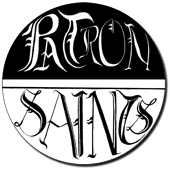 Our Patron Saints sign, created in 1971 by John Doerschuk and Lynn Latimer, accompanied us to every gig. |
After we completed Bohob and had finished handing out copies to anyone who showed even a mild interest in one, we broke up. I don't remember why, exactly. Maybe we didn't feel like waiting 25 or 30 years to become recognized! I think that Jon was getting ready to go away to college in the fall...that may have been it. Whatever it was, the Patron Saints were in limbo again. |
||||||||||
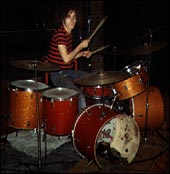 Joe Ivins, drumming in 1971. |
Sometime during the Fall, Joe and I went up to Horace Greeley High School in Chappaqua, New York, to hang out. A student talent show was in rehearsal, and they were short some musicians for some of the acts. Somehow or other, Joe and I got roped into playing drums and bass for a couple of numbers. |
||||||||||
|
I was getting that old recording itch again; both Jon and I had new songs that we wanted to get down on tape, so we started to search for another place to record. A band friend, Lynn Latimer, offered her family's basement...we could even move the family piano down from the living room! It was too good to be true...her parents were even into it! Lynn, along with friends Dan Reiner and Jackie Fornerod pitched in for the cause. |
||||||||||
 Me, with my Framus Texan 12-string, and Kirk, during the recording of The Latimer Sessions, in 1971. |
We brought in our equipment, put up blankets for soundproofing, set up mikes...I think we envisioned this as Fohhoh Bohob: The Sequel. We had better decks and mixers than before, and we felt confident that we could produce something marketable this time around, since nothing seemed to be happening with our one and only almost two-year-old record. Jon came down from Massachusetts when he could, which was not too often...we had been essentially a four-piece band since Kirk joined, practicing and recording, for the most part, without Jon. Finally, in April of 1971, he made it official: Jon was leaving the group for personal reasons. |
||||||||||
|
We weren't sure if the final product was good enough for vinyl, but it was definitely useful as a demonstration tape for the band. We brought copies of the tapes everywhere and sent a number out to various record companies, including the Moody Blues' newly formed Threshold label. Unfortunately, they sent us back someone else's demo tape. Another band must have ours; to this day, I expect to hear our songs pop up on someone else's album! |
||||||||||
 Cover for The Patron Saints' The Latimer Sessions, which was finally released on CD in 2000. |
The Latimer Sessions, as they came to be called, allowed us to gel as a band. In 2000, by popular demand, we finally released The Latimer Sessions on CD. We played a lot of jobs that summer and continued into 1972 (To the right is a QuickTime movie of us at an outdoor concert in August, 1971). We disbanded at some point, but in early 1973, the Patron Saints reformed and decided, once more, to try our hand at recording ourselves. We bought even better tape equipment, and constructed a new studio (nicknamed "The Bunker") in the attic of the house Joe, his wife April, and our friend Don Kratzke lived in. Don and I did most of the design and construction; we really wanted to do it right this time. Finally, tape started rolling in May. At some point during this period, we decided that the name Patron Saints had outlived it's practical usefulness and changed it to Diamond Reo, after the garbage truck line (which, of course another group had thought of and used). Since we never performed publicly as a group after this point, nobody but us ever knew (or cared, for that matter!). Another group used the name, so it's just as well. |
||||||||||
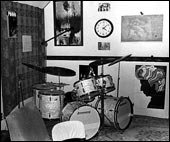 Our studio, 'The Bunker,' where The Patron Saints recorded in 1973. |
The Patron Saints eventually morphed into the group Garrison, but the next phase of the Saints' story continues with the reunion concert in 2000... All photos of the Patron Saints from the Latimer Sessions taken by Dan Reiner. Live photos taken by Lynn Latimer. Studio photo by Don Kratzke. |
||||||||||
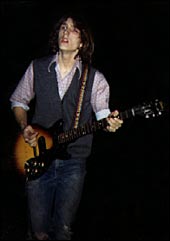
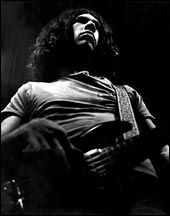
 A few of the skits included an extremely talented student acting and playing guitar and piano. Joe and I started were thinking seriously about reforming the Saints at this point, so we were on the lookout for likely candidates. This guy seemed real likely to us! And so, John Doerschuk became the next member of the resuscitated Patron Saints. I called Jon Tuttle at college, and he wanted in, even though it meant that he would have to commute from Massachusetts to participate. So, in the late fall of 1969, the Patron Saints began anew, once again. We practiced at our pal Charlie Wilhelm's house a lot and played a number of jobs until the summer of 1970. It was the first time that Jon and I were in a group that actually performed our original music live. What was great about this incarnation of the group was the musical flexibility we possessed...both Jon and John were terrific guitarists and keyboard players.
A few of the skits included an extremely talented student acting and playing guitar and piano. Joe and I started were thinking seriously about reforming the Saints at this point, so we were on the lookout for likely candidates. This guy seemed real likely to us! And so, John Doerschuk became the next member of the resuscitated Patron Saints. I called Jon Tuttle at college, and he wanted in, even though it meant that he would have to commute from Massachusetts to participate. So, in the late fall of 1969, the Patron Saints began anew, once again. We practiced at our pal Charlie Wilhelm's house a lot and played a number of jobs until the summer of 1970. It was the first time that Jon and I were in a group that actually performed our original music live. What was great about this incarnation of the group was the musical flexibility we possessed...both Jon and John were terrific guitarists and keyboard players.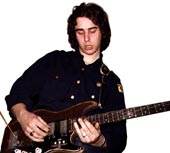
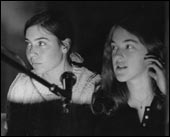
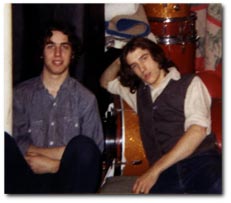 So now we were back to four: me, Joe, John and Kirk. At the end of April 1971, we finished creating our new "masterpiece." The final product was a mixed bag of styles, just as Bohob had been, with rock, pop, folk, R & B, and music hall. Most of the songs were new, but we also re-recorded versions of Flower, Do You Think About Me?, White Light and Andrea, all of which appeared originally on Fohhoh Bohob. Lynn and Jackie sang on Golden Richard, the last song we recorded; the first "female" voices to appear officially on a Patron Saints recording.
So now we were back to four: me, Joe, John and Kirk. At the end of April 1971, we finished creating our new "masterpiece." The final product was a mixed bag of styles, just as Bohob had been, with rock, pop, folk, R & B, and music hall. Most of the songs were new, but we also re-recorded versions of Flower, Do You Think About Me?, White Light and Andrea, all of which appeared originally on Fohhoh Bohob. Lynn and Jackie sang on Golden Richard, the last song we recorded; the first "female" voices to appear officially on a Patron Saints recording. We did a lot of good work in that attic. I had written a fair number of new songs which we were able to try out, including One For The Road, a re-recorded version of which ended up on my 1978 album release,
We did a lot of good work in that attic. I had written a fair number of new songs which we were able to try out, including One For The Road, a re-recorded version of which ended up on my 1978 album release,